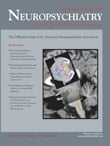To the Editor: In the past, paroxysmal movement disorders were often diagnosed as seizures. The current clinical recognition that they are distinct from epilepsies has been challenged by recent clinical, electrophysiological, and genetic observations.
1 Here we report a patient with an unusual association of déjà vu aura and movement-induced paroxysmal hyperkinetic attacks which were consistent with idiopathic paroxysmal kinesigenic dyskinesia.
Case Report
A 23-year-old right-handed man of Afro-Caribbean descent presented with a 10-year history of paroxysmal abnormal movements associated with déjà vu aura. His attacks were initially unilateral and involved his left big toe crossing over the next. Over the years they progressed and alternated sides. Current habitual attack leads to “hitch hiker” posture in his right arm followed with generalization. Its phenomenology is that of combination of dystonia, choreoathetotic movements, ballismus, and other hyperkinesias. There was no associated loss of consciousness or pain. The duration of the attack was initially 5–10 seconds, but new attacks could last up to 15–20 seconds. In the interictal period, no laterality or abnormality of his movement, posture, or muscle tone was present. One year into the presentation, he started noticing the association of the attacks with a déjà vu feeling.
“It is there before it starts. As though I have seen this room before or had this conversation already. Following that I get this feeling in my body, in my chest or tingling in my arm. But déjà vu is always there first.”
A whole-body activity such as initiation of standing or walking was the typical trigger to his attacks, but sometimes it was a focal movement, such as stretching of his arm. Startle was also a trigger on rare occasions. Sometimes he would feel focal numbness or a tingling sensation in the periphery where the involuntary movement was about to begin. His attacks could be either minimized or prevented if he stopped his movement when he first felt the premonitory sensation. Reportedly his attacks were worse during the winter and in cold periods, and at their worst they were happening every 10 minutes. There was an immediate and remarkable response to carbamazepine. His attacks were, however, only partially controlled as he had difficulty adhering to doses higher than 600 mg daily due to oversedation and disturbed sleep. Lamotrigine was also tried, but it caused a rash. He eventually stabilized on 600 mg oxcarbamazepine daily, with fewer than three attacks per month. His general, mental, and neurological examinations disclosed no remarkable findings. His psychiatric, medical, and family history was otherwise unremarkable. The results of laboratory examinations and cerebral MRI were all reported normal. During several days of video-telemetry, several stereotyped habitual hyperkinetic attacks with déjà vu were captured, none arising from sleep. His ictal EEGs, during one of which he managed to count backward, showed no paroxysmal discharges.
Discussion
The debate about the pathophysiological basis of paroxysmal kinesigenic dyskinesia concerning reflex epilepsy versus dysfunction of basal ganglia is as present as ever.
1,
2 However, the growing body of clinical and research data suggests that a pathophysiological abnormality may be shared, genetically determined, and variably expressed in the cerebral cortex and in the basal ganglia.
1 –
3The hypothesis that paroxysmal kinesigenic dyskinesia is a channelopathy, where the primary pathophysiological process is that of epilepsy arising at a subcortical level, has also been proposed.
2 The presence of premonitory sensation, the paroxysmal character and brevity of attacks, as well as their response to antiepileptic drugs, are all well recognized features of paroxysmal kinesigenic dyskinesia which offer support to this hypothesis.
2 Furthermore, there are several reports of families in which some individuals presented with paroxysmal kinesigenic dyskinesia and epilepsy with different age-related expression.
1,
3In one study, the attacks in a patient with paroxysmal kinesigenic dyskinesia, which were investigated by invasive long-term electrode monitoring, were shown to be epileptic in nature.
4 The epileptogenic source was reported within the supplementary sensory motor cortex with the ictal discharge rapidly spreading to the ipsilateral caudate nucleus. In our patient, the episodic dyskinetic attacks were reported to start with déjà vu aura, suggesting cortical involvement, and were clinically recognized as paroxysmal kinesigenic dyskinesia. Although the surface EEG recording in our patient did not show any epileptic activity, we cannot exclude the possibility that his dyskinetic attacks were epileptic in origin. However, in all other clinical characteristics (trigger, premonitory sensation, phenomenology, and antiepileptic drug responsiveness), our patient satisfied clinical criteria for evaluation of paroxysmal kinesigenic dyskinesia recently suggested by Bruno et al.
5Déjà vu experiences are also known to occur in the normal population and are thought to result from a faulty and isolated activity of a recognition memory system (i.e., the parahippocampal gyrus and its neocortical connections).
6 In a recent study of the functional anatomy of déjà vu aura in temporal lobe epilepsy, it was suggested that temporal lobe dysfunction is necessary but not sufficient for its generation and that extensive association cortical areas may be involved as part of the network that integrates this distinct experience.
7 To our knowledge, this is the first report to show the association of paroxysmal kinesigenic dyskinesia and dysmnesic déjà vu phenomena.
Definitions of epilepsy and epileptic seizures have recently undergone a significant revision.
8 While the cerebral cortex is still recognized as the primary element in the generation of epileptic seizures, it is not the only one, and subcortical sources are now also accepted. Thus, given overlapping pathophysiological basis and overlapping anatomical substrates for paroxysmal kinesigenic dyskinesia and some epilepsy syndromes, neither of these alone can be used as the basis for the diagnosis, and the clinical presentation remains paramount. Finally, one can speculate that the déjà vu experiences present a hitherto unreported facet of the spectrum of premonitory sensations which were previously recorded in paroxysmal kinesigenic dyskinesia.
5
